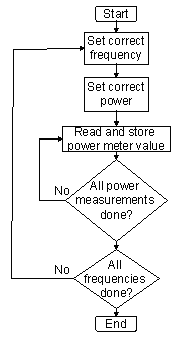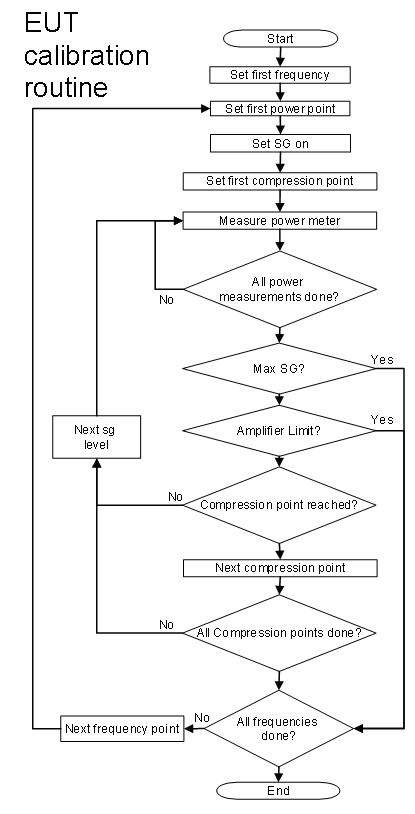Chapter 12: Difference between revisions
No edit summary |
|||
| Line 3: | Line 3: | ||
==Introduction== | ==Introduction== | ||
During a calibration, | During a calibration, {{RadiMation}} stores all equipment under test used during the calibration. If the test equipment used can return it’s serial number through the IEEE bus, this serial number will be recorded. | ||
Furthermore, all settings (like start frequency, stop frequency, probe response time, frequency step size, calibration type (FWD, transmitted or signal generator level, etc.) are recorded. | Furthermore, all settings (like start frequency, stop frequency, probe response time, frequency step size, calibration type (FWD, transmitted or signal generator level, etc.) are recorded. | ||
Furthermore, the following graphs are stored: | Furthermore, the following graphs are stored: | ||
*The achieved field strength (or current) during calibration. | * The achieved field strength (or current) during calibration. | ||
*The signal generator level, necessary to achieve this field strength (or current level) | * The signal generator level, necessary to achieve this field strength (or current level) | ||
*The Forward power, necessary to achieve this field strength (or current level) | * The Forward power, necessary to achieve this field strength (or current level) | ||
*The transmitted power, necessary to achieve this field strength (or current level) | * The transmitted power, necessary to achieve this field strength (or current level) | ||
{{Note|When a signal level calibration is made and no power meters are used, the forward and reflected power graphs are not stored. | {{Note|When a signal level calibration is made and no power meters are used, the forward and reflected power graphs are not stored. | ||
| Line 22: | Line 22: | ||
===Frequency interpolation of Calibration files=== | ===Frequency interpolation of Calibration files=== | ||
{{RadiMation}} allows you to use a frequency step size during a test, which is smaller than the frequency step size during the calibration. For this purpose {{RadiMation}} uses a linear interpolation between the frequency point which is just below the desired test point and the frequency point which is directly above the test point. Of coarse frequency interpolation will reduce the accuracy of the test level, and should therefore only be used during pre-compliance tests. | |||
===Amplitude extrapolation of calibration files=== | ===Amplitude extrapolation of calibration files=== | ||
{{RadiMation}} allows you to run a test at a different test level as used during the calibration. For this purpose {{RadiMation}} uses a linear extrapolation from the calibration level to the desired level. | |||
If, for example at a certain frequency point 100 Watt (+50 dBm) is needed to generate a field of 10 V/m (which is determined during calibration) and one wants to use this calibration file to run a test at 3 V/m, RadiMation® will use a power level of 50 DBm - 20 log (10/3) = 40 dBm (10 Watt). Of coarse, amplitude interpolation will reduce the accuracy of the test level and should therefore only be used during pre-compliance tests. | If, for example at a certain frequency point 100 Watt (+50 dBm) is needed to generate a field of 10 V/m (which is determined during calibration) and one wants to use this calibration file to run a test at 3 V/m, RadiMation® will use a power level of 50 DBm - 20 log (10/3) = 40 dBm (10 Watt). Of coarse, amplitude interpolation will reduce the accuracy of the test level and should therefore only be used during pre-compliance tests. | ||
{{warning|The amplitude extrapolation will only be correct if the power amplifier works in its linear region. | {{warning|The amplitude extrapolation will only be correct if the power amplifier works in its linear region. | ||
{{RadiMation}} supports three different ways of power calibration. During the configuration of the calibration, the desired method should be selected. During a test, when a calibration file is selected, {{RadiMation}} automatically selects the method used during calibration.}} | |||
==Calibration methods== | ==Calibration methods== | ||
| Line 53: | Line 51: | ||
===Radiated immunity calibration=== | ===Radiated immunity calibration=== | ||
Calibration of the radiated immunity test set-up is necessary when tests in accordance to the substitution method are performed. | Calibration of the [[radiated immunity]] test set-up is necessary when tests in accordance to the substitution method are performed. | ||
During a substitution test, first the empty anechoic room is calibrated (i.e.: the power to the transmitting antenna is recorded which is necessary to achieve the desired field strength in the room). During the test the EUT is placed inside the anechoic chamber, and the same power is applied to the transmitting antenna. | During a substitution test, first the empty anechoic room is calibrated (i.e.: the power to the transmitting antenna is recorded which is necessary to achieve the desired field strength in the room). During the test the [[EUT]] is placed inside the anechoic chamber, and the same power is applied to the transmitting antenna. | ||
====One-point calibration==== | ====One-point calibration==== | ||
During a 1-point calibration, | During a 1-point calibration, {{RadiMation}} for each frequency point increases the power to the antenna, until the desired field strength is reached. Then, depending on the type of calibration RadiMation® records the Signal generator level, FWD power and/or transmitted power in the calibration file. | ||
To start a radiated immunity one-point calibration please select: | To start a [[radiated immunity]] one-point calibration please select: | ||
{{menu|Calibration|Radiated Immunity|1 Point Calibration}} | {{menu|Calibration|Radiated Immunity|1 Point Calibration}} | ||
| Line 113: | Line 111: | ||
===16 point field homogeneity verification=== | ===16 point field homogeneity verification=== | ||
The EN 61000-4-3 states that the anechoic room must have a | The EN 61000-4-3 (and other standards) states that the anechoic room must have a homogeneous field distribution in a 1.5 m. x 1.5 m. square area, 80 cm. above the ground. | ||
The field is defined as | The field is defined as homogeneous if, at 12 of 16 points in the 1.5 m. x 1.5 m. square the field strength lies between the desired value and the desired value plus 6 dB (see the figure below). | ||
If, for example, the field homogeneity check is made at a field strength of 10 V/m, 12 of the 16 points must lie between 10 V/m and 20 V/m. | If, for example, the field homogeneity check is made at a field strength of 10 V/m, 12 of the 16 points must lie between 10 V/m and 20 V/m. | ||
For this purpose, sixteen | For this purpose, sixteen '1 point calibrations' must be performed. After all 16 calibrations are carried out, the 16 point field homogeneity verification software can be used to verify the field homogeneity in the room. | ||
The sixteen-point verification is started by selecting: | The sixteen-point verification is started by selecting: | ||
| Line 136: | Line 133: | ||
[[Image:Radiated Immunity Uniform Field Area Calculation Settings.png]] | [[Image:Radiated Immunity Uniform Field Area Calculation Settings.png]] | ||
The | The {{RadiMation}} package supports different ways to calculate the uniformity of a field, to determine the 4 points (out of the 16 points) which must be ignored for each test frequency. | ||
* EN 61000-4-3 1995 | |||
* EN 61000-4-3 2002 | |||
* EN 61000-4-3 2002 Amendment 1 | |||
* EN 61000-4-3 2006 | |||
#Use one time averaging | #Use one time averaging | ||
#Use four time averaging | #Use four time averaging | ||
One time averaging | === One time averaging === | ||
With this method, the software, for each frequency point, will take the average of all 16 test points, and will determine the four points which differ the most from the average. For this frequency, these four test points will be removed from the calibration file. | With this method, the software, for each frequency point, will take the average of all 16 test points, and will determine the four points which differ the most from the average. For this frequency, these four test points will be removed from the calibration file. | ||
Four time averaging | === Four time averaging === | ||
With this method, the software, for each frequency point, will use the following procedure: | With this method, the software, for each frequency point, will use the following procedure: | ||
| Line 154: | Line 158: | ||
#The software takes the average of the remaining 13 test points, and determines the point, which differs the most from this new average. For this frequency, this point will be removed from the calibration file. | #The software takes the average of the remaining 13 test points, and determines the point, which differs the most from this new average. For this frequency, this point will be removed from the calibration file. | ||
After | After {{RadiMation}} has calculated the complete calibration file, the following information will be displayed: | ||
Graphical representation of the calibration results: | Graphical representation of the calibration results: | ||
{{RadiMation}} will display 16 coloured dots on the screen, each dot representing a test point in the anechoic room. At the side of these dots, the test frequency can be incremented, which will directly show the new information for the 16 points as represented in the picture below. | |||
[[Image:Radiated Immunity Uniform Field Area Calculation Result Window.png]] | [[Image:Radiated Immunity Uniform Field Area Calculation Result Window.png]] | ||
| Line 187: | Line 191: | ||
===Calibration information that is stored after verification=== | ===Calibration information that is stored after verification=== | ||
Now that Radimation has determined the homogeneity, what is the information that is stored in the calibration file? And why? | Now that {{Radimation}} has determined the homogeneity, what is the information that is stored in the calibration file? And why? | ||
The method below describes for the signal generator level but also applies for the forward power and the net power calibration. | The method below describes for the signal generator level but also applies for the forward power and the net power calibration. | ||
The software has determined the remaining 12 points for each frequency according to the chapter | The software has determined the remaining 12 points for each frequency according to the chapter '16 point field homogeneity verification'. | ||
With only 1 signal generator at hand its impossible to set all the 12 levels. So you would say take the average of all the levels and you are done. This would be right for about 50% of the verifications. But with a simple example it can be proven that this is not the right method. | With only 1 signal generator at hand its impossible to set all the 12 levels. So you would say take the average of all the levels and you are done. This would be right for about 50% of the verifications. But with a simple example it can be proven that this is not the right method. | ||
| Line 230: | Line 234: | ||
A better way is to use the highest value. When you perform a substitution with the highest level you can be 100% that the field is at least 10 V/m at 12 of the 16 points. | A better way is to use the highest value. When you perform a substitution with the highest level you can be 100% that the field is at least 10 V/m at 12 of the 16 points. | ||
That is why Radimation saves the highest level in the calibration file. | That is why {{Radimation}} saves the highest level in the calibration file. | ||
==Triplate calibration== | ==Triplate calibration== | ||
The triplate calibration needs to be performed in order to perform the triplate test. With the triplate calibration you determine the impedance of the triplate, which is needed to calculate the field. | The [[triplate]] calibration needs to be performed in order to perform the triplate test. With the triplate calibration you determine the impedance of the triplate, which is needed to calculate the field. | ||
During the calibration the field is set on a constant level, there are several reasons for doing so. | During the calibration the field is set on a constant level, there are several reasons for doing so. | ||
#Some fieldsensors have problems with their ranges, to avoid these problems it is better to field level. | # Some fieldsensors have problems with their ranges, to avoid these problems it is better to field level. | ||
#With fixed field you are aways sure that the required level is there, if you use fixed power there may be a big dip or peak in the calibration. This can give interpolation errors. For example a fixed power test at 50 dBm generates a field of 100 V/m at 100 MHz but generates a field of 80 V/m at 800 MHz due to the amplifier/powermeters/cables and couplers. Suppose Radimation uses these values to generate a fixed field of 110 V/m. The error made when extrapolation from 100V/m will be much smaller then from 80 V/m. | # With fixed field you are aways sure that the required level is there, if you use fixed power there may be a big dip or peak in the calibration. This can give interpolation errors. For example a fixed power test at 50 dBm generates a field of 100 V/m at 100 MHz but generates a field of 80 V/m at 800 MHz due to the amplifier/powermeters/cables and couplers. Suppose {{Radimation}} uses these values to generate a fixed field of 110 V/m. The error made when extrapolation from 100V/m will be much smaller then from 80 V/m. | ||
#Error field sensor | # Error field sensor vs. error powermeter, when performing a fixed power you can have problems with the linearity of your system. In general you can say that your powersensors are better in the linear response then your fieldsensor, so when you are leveling on the field sensor you are sure that the linearity error is reduced to the minimum. | ||
===One point calibration=== | ===One point calibration=== | ||
| Line 249: | Line 253: | ||
To define the fieldprobe position in height use the antenna distance. Polarization does not influence this calibration. | To define the fieldprobe position in height use the antenna distance. Polarization does not influence this calibration. | ||
A description of the rest of the settings can be found in the manual chapter | A description of the rest of the settings can be found in the manual in the chapter 'Radiated immunity calibration'. | ||
[[Image:Radiated Immunity Test Setup Calibration Triplate.png]] | [[Image:Radiated Immunity Test Setup Calibration Triplate.png]] | ||
{| | {| | ||
!Device name || Tab in Radimation configuration window | !Device name || Tab in {{Radimation}} configuration window | ||
|- | |- | ||
|Signal Generator || Standard 1 | |Signal Generator || Standard 1 | ||
| Line 274: | Line 278: | ||
|+'''Cables''' | |+'''Cables''' | ||
|- | |- | ||
!# || Device name || Tab in Radimation configuration window | !# || Device name || Tab in {{Radimation}} configuration window | ||
|- | |- | ||
|1 || Sign-> Amp || Cables | |1 || Sign-> Amp || Cables | ||
| Line 287: | Line 291: | ||
|} | |} | ||
{{Note|Usage of cable correction factors is not mandatory. However, using correction factors will increase measurement | {{Note|Usage of cable correction factors is not mandatory. However, using correction factors will increase measurement accuracy during immunity measurements. | ||
When in doubt contact your reseller. | When in doubt contact your reseller. | ||
| Line 305: | Line 309: | ||
<math>Z(f)=h^2*\frac{{E_{avg}}^2(f)}{P_{mid}(f)} [\Omega]</math> | <math>Z(f)=h^2*\frac{{E_{avg}}^2(f)}{P_{mid}(f)} [\Omega]</math> | ||
'''Formula 12 1: Impedance''' | '''Formula 12-1: Impedance''' | ||
<math>P_{mid}(f)=\frac{P_{net}(f)[W] + P_{out}(f)[W]}{2}</math> | <math>P_{mid}(f)=\frac{P_{net}(f)[W] + P_{out}(f)[W]}{2}</math> | ||
'''Formula 12 2: Middle power calculation''' | '''Formula 12-2: Middle power calculation''' | ||
==Conducted immunity calibration== | ==Conducted immunity calibration== | ||
| Line 335: | Line 339: | ||
<math>U_{powerhead}=U_{rms} - 6[dB]-20*^{10}Log\frac{50}{150}= U_{rms}-15,6[dB]</math> | <math>U_{powerhead}=U_{rms} - 6[dB]-20*^{10}Log\frac{50}{150}= U_{rms}-15,6[dB]</math> | ||
Formula 12 3: Expected powermeter reading | '''Formula 12-3: Expected powermeter reading''' | ||
'''Example:''' | '''Example:''' | ||
| Line 347: | Line 351: | ||
{| | {| | ||
!Device name || Tab in Radimation configuration window | !Device name || Tab in {{Radimation}} configuration window | ||
|- | |- | ||
|Signal Generator || Standard 1 | |Signal Generator || Standard 1 | ||
| Line 369: | Line 373: | ||
|+'''Cables''' | |+'''Cables''' | ||
|- | |- | ||
!# || Device name || Tab in Radimation configuration window | !# || Device name || Tab in {{Radimation}} configuration window | ||
|- | |- | ||
|1 || Sign-> Amp || Cables | |1 || Sign-> Amp || Cables | ||
| Line 384: | Line 388: | ||
|} | |} | ||
{{Note|Usage of cable correction factors is not mandatory. However, using correction factors will increase measurement | {{Note|Usage of cable correction factors is not mandatory. However, using correction factors will increase measurement accuracy during immunity measurements. | ||
When in doubt contact your reseller. | When in doubt contact your reseller. | ||
Revision as of 15:26, 12 January 2009
Calibration[edit]
Introduction[edit]
During a calibration, RadiMation® stores all equipment under test used during the calibration. If the test equipment used can return it’s serial number through the IEEE bus, this serial number will be recorded.
Furthermore, all settings (like start frequency, stop frequency, probe response time, frequency step size, calibration type (FWD, transmitted or signal generator level, etc.) are recorded.
Furthermore, the following graphs are stored:
- The achieved field strength (or current) during calibration.
- The signal generator level, necessary to achieve this field strength (or current level)
- The Forward power, necessary to achieve this field strength (or current level)
- The transmitted power, necessary to achieve this field strength (or current level)
| Note: | When a signal level calibration is made and no power meters are used, the forward and reflected power graphs are not stored.
When a forward power calibration is made and no reflected power meter is used, the reflected power graph is not stored. |
All can be viewed and printed by the operator.
To view calibration data, open the calibration file through the File, Open, calibration pull down menu. When a calibration window is opened, the calibration configuration data, as well as the Equipment used, is displayed.
Frequency interpolation of Calibration files[edit]
RadiMation® allows you to use a frequency step size during a test, which is smaller than the frequency step size during the calibration. For this purpose RadiMation® uses a linear interpolation between the frequency point which is just below the desired test point and the frequency point which is directly above the test point. Of coarse frequency interpolation will reduce the accuracy of the test level, and should therefore only be used during pre-compliance tests.
Amplitude extrapolation of calibration files[edit]
RadiMation® allows you to run a test at a different test level as used during the calibration. For this purpose RadiMation® uses a linear extrapolation from the calibration level to the desired level.
If, for example at a certain frequency point 100 Watt (+50 dBm) is needed to generate a field of 10 V/m (which is determined during calibration) and one wants to use this calibration file to run a test at 3 V/m, RadiMation® will use a power level of 50 DBm - 20 log (10/3) = 40 dBm (10 Watt). Of coarse, amplitude interpolation will reduce the accuracy of the test level and should therefore only be used during pre-compliance tests.
| Warning: | The amplitude extrapolation will only be correct if the power amplifier works in its linear region.
RadiMation® supports three different ways of power calibration. During the configuration of the calibration, the desired method should be selected. During a test, when a calibration file is selected, RadiMation® automatically selects the method used during calibration. |
Calibration methods[edit]
Signal generator level calibration[edit]
During signal generator level calibration only the signal generator level is recorded during the calibration. This method does not take amplifier instability into account. During this calibration method no power meters are required. This method is less accurate than the FWD power and transmitted power calibrations and therefore not recommended for full compliance tests.
Forward power calibration[edit]
During a Forward power calibration, the forward power to the transmitting antenna is recorded. During a test, the FWD power to the antenna is kept the same as during the calibration. By this method, amplifier drift will have no influence on the test.
Net power calibration[edit]
During a Net power calibration, the Forward and Reflected power to the antenna are recorded. The difference between the FWD power and Reflected power is the Transmitted power. During a test, the Transmitted power is kept the same as during calibration. When a large metallic, EUT is placed in front of the antenna, some RF energy is reflected back into the antenna, resulting in a worse VSWR. When only FWD power is calibrated, this effect is not compensated for. When transmitted power is calibrated, the by the antenna transmitted power is kept the same as during calibration.
Radiated immunity calibration[edit]
Calibration of the radiated immunity test set-up is necessary when tests in accordance to the substitution method are performed. During a substitution test, first the empty anechoic room is calibrated (i.e.: the power to the transmitting antenna is recorded which is necessary to achieve the desired field strength in the room). During the test the EUT is placed inside the anechoic chamber, and the same power is applied to the transmitting antenna.
One-point calibration[edit]
During a 1-point calibration, RadiMation® for each frequency point increases the power to the antenna, until the desired field strength is reached. Then, depending on the type of calibration RadiMation® records the Signal generator level, FWD power and/or transmitted power in the calibration file. To start a radiated immunity one-point calibration please select:
-
 Calibration
Calibration
-
 Radiated Immunity
Radiated Immunity
-
 1 Point Calibration
1 Point Calibration
-
-
-
After this you are asked to select a TSF file from the list of available calibration TSF files as shown in the picture below.
File:Select TSF File 1 Point Calibration Window.png
The typical calibration TSF file looks like the picture shown below.
| Device name | Tab in Radimation configuration window |
|---|---|
| Signal Generator | Standard 1 |
| Amplifier | Standard 1 |
| Coupler | Standard 1 |
| Power meter Pfwd | Standard 1 |
| Power meter Refl | Standard 1 |
| Antenna | Standard 1 |
| Field sensor | Field probes |
| # | Device name | Tab in Radimation configuration window |
|---|---|---|
| 1 | Sign-> Amp | Cables |
| 2 | Amp-> Coupler | Cables |
| 3 | Coup->Ant | Cables |
| 4 | Coup->Pfwd | Cables |
| 5 | Coup->Pref | Cables |
| Note: | Usage of cable correction factors is not mandatory. However, using correction factors will increase measurement accuraccy during immunity measurements.
When in doubt contact your reseller. |
16 point field homogeneity verification[edit]
The EN 61000-4-3 (and other standards) states that the anechoic room must have a homogeneous field distribution in a 1.5 m. x 1.5 m. square area, 80 cm. above the ground.
The field is defined as homogeneous if, at 12 of 16 points in the 1.5 m. x 1.5 m. square the field strength lies between the desired value and the desired value plus 6 dB (see the figure below).
If, for example, the field homogeneity check is made at a field strength of 10 V/m, 12 of the 16 points must lie between 10 V/m and 20 V/m.
For this purpose, sixteen '1 point calibrations' must be performed. After all 16 calibrations are carried out, the 16 point field homogeneity verification software can be used to verify the field homogeneity in the room.
The sixteen-point verification is started by selecting:
-
 Calibration
Calibration
-
 Radiated immunity
Radiated immunity
-
 16 Point Calibration
16 Point Calibration
-
-
-
The user is requested to select a calibration TSF file from the list of available TSF files as shown below.
File:Select TSF File 16 Point Calibration Window.png
After a calibration TSF file is selected a typical 16 point calibration TSF will appear like the one shown in the picture below.
The RadiMation® package supports different ways to calculate the uniformity of a field, to determine the 4 points (out of the 16 points) which must be ignored for each test frequency.
- EN 61000-4-3 1995
- EN 61000-4-3 2002
- EN 61000-4-3 2002 Amendment 1
- EN 61000-4-3 2006
- Use one time averaging
- Use four time averaging
One time averaging[edit]
With this method, the software, for each frequency point, will take the average of all 16 test points, and will determine the four points which differ the most from the average. For this frequency, these four test points will be removed from the calibration file.
Four time averaging[edit]
With this method, the software, for each frequency point, will use the following procedure:
- The software takes the average of all 16 test-points, and will determine the test point, which differs the most from the average. For this frequency, this point will be removed from the calibration file.
- The software takes the average of the remaining 15 test points, and determines the point, which differs the most from this new average. For this frequency, this point will be removed from the calibration file.
- The software takes the average of the remaining 14 test points, and determines the point, which differs the most from this new average. For this frequency, this point will be removed from the calibration file.
- The software takes the average of the remaining 13 test points, and determines the point, which differs the most from this new average. For this frequency, this point will be removed from the calibration file.
After RadiMation® has calculated the complete calibration file, the following information will be displayed:
Graphical representation of the calibration results:
RadiMation® will display 16 coloured dots on the screen, each dot representing a test point in the anechoic room. At the side of these dots, the test frequency can be incremented, which will directly show the new information for the 16 points as represented in the picture below.
The colours of the dots have the following meaning:
- Green dot, This point is one of the 12 points, which are taken into account for the calibration file.
- Yellow dot, This point is one of the 4 points, which differ the most from the average of the 16 points.
- Red dot, This point is one of the 12 remaining points, however, it has an error of more than 6 dB (i.e. the room does not meet the field homogeneity requirements for this point!).
Graphs for final calibration file:
- Overall error graph (to verify if 12 of the 16 points lie within the 6 dB error)
- Signal generator level graph.
- Forward power level graph (only if the forward or net power calibration method is used).
- Net power level graph (only if the net power calibration method is used).
Graphs for each calibration point:
- Calculated field graphs: When the final calibration file is applied, these graphs display the calculated field for the selected test point location.
- Forward power graphs: Forward power used to achieve the desired field strength. This graph is corrected for the calibration (field) uncertainty. If the calibration is made at a test level of 10 V/m with a uncertainty of 1 V/m, the software will calculate the real forward power to achieve exactly 10 V/m (even if the calibration is made at for example 9.4 V/m).
- Error graphs: These graphs display the errors for the selected test point location. On frequencies where the test point was not taken into account for the calibration file, the error is set to zero. (i.e. this frequency point is one of the 4 points which where ignored).
Calibration information that is stored after verification[edit]
Now that RadiMation® has determined the homogeneity, what is the information that is stored in the calibration file? And why? The method below describes for the signal generator level but also applies for the forward power and the net power calibration.
The software has determined the remaining 12 points for each frequency according to the chapter '16 point field homogeneity verification'.
With only 1 signal generator at hand its impossible to set all the 12 levels. So you would say take the average of all the levels and you are done. This would be right for about 50% of the verifications. But with a simple example it can be proven that this is not the right method.
Suppose you have the following 12 points left at 100 MHz:
| Point | Signal level (dBm) |
|---|---|
| 1 | -10 |
| 2 | -10 |
| 3 | -8 |
| 4 | -12 |
| 5 | -8 |
| 6 | -12 |
| 7 | -8 |
| 8 | -12 |
| 9 | -11 |
| 10 | -9 |
| 11 | -13 |
| 12 | -7 |
The average will give –10 dBm.
This means that with points 3,5,7,10 and 12 you are not generating enough power, because for these points you need a higher signal level. Worst case (number 12), you will generate only around 7 V/m instead of 10 V/m.
A better way is to use the highest value. When you perform a substitution with the highest level you can be 100% that the field is at least 10 V/m at 12 of the 16 points.
That is why RadiMation® saves the highest level in the calibration file.
Triplate calibration[edit]
The triplate calibration needs to be performed in order to perform the triplate test. With the triplate calibration you determine the impedance of the triplate, which is needed to calculate the field.
During the calibration the field is set on a constant level, there are several reasons for doing so.
- Some fieldsensors have problems with their ranges, to avoid these problems it is better to field level.
- With fixed field you are aways sure that the required level is there, if you use fixed power there may be a big dip or peak in the calibration. This can give interpolation errors. For example a fixed power test at 50 dBm generates a field of 100 V/m at 100 MHz but generates a field of 80 V/m at 800 MHz due to the amplifier/powermeters/cables and couplers. Suppose RadiMation® uses these values to generate a fixed field of 110 V/m. The error made when extrapolation from 100V/m will be much smaller then from 80 V/m.
- Error field sensor vs. error powermeter, when performing a fixed power you can have problems with the linearity of your system. In general you can say that your powersensors are better in the linear response then your fieldsensor, so when you are leveling on the field sensor you are sure that the linearity error is reduced to the minimum.
One point calibration[edit]
To start a one-point calibration, close all EUT windows. And select the one point calibration.
-
 Calibration
Calibration
-
 Radiated Immunity
Radiated Immunity
-
 1 Point Calibration
1 Point Calibration
-
-
-
A new window will appear, allowing you to set up the calibration. The difference between a chamber calibration and a triplate calibration is the out power. To perform a triplate calibration Net-power needs to be selected as well as outpower.
To define the fieldprobe position in height use the antenna distance. Polarization does not influence this calibration. A description of the rest of the settings can be found in the manual in the chapter 'Radiated immunity calibration'.
| Device name | Tab in RadiMation® configuration window |
|---|---|
| Signal Generator | Standard 1 |
| Amplifier | Standard 1 |
| Coupler | Standard 1 |
| Power meter Pfwd | Standard 1 |
| Power meter Refl | Standard 1 |
| Antenna | Standard 1 |
| Field sensor | Field probes |
| # | Device name | Tab in RadiMation® configuration window |
|---|---|---|
| 1 | Sign-> Amp | Cables |
| 2 | Amp-> Coupler | Cables |
| 3 | Coup->Ant | Cables |
| 4 | Coup->Pfwd | Cables |
| 5 | Coup->Pref | Cables |
| Note: | Usage of cable correction factors is not mandatory. However, using correction factors will increase measurement accuracy during immunity measurements.
When in doubt contact your reseller. |
Merge five one point calibration into one final calibration[edit]
To merge the five calibrations into one, select the 16-point calibration.
-
 Calibration
Calibration
-
 Radiated Immunity
Radiated Immunity
-
 16 Point Calibration
16 Point Calibration
-
-
-
In the following screen select the five one-point calibration files you want to merge, after that select determine Z.
Select calculate to start the calculation, when the calculation is done save the information and you can perform a triplate test.
The following formulas are used to determine the impedance of the triplate
Formula 12-1: Impedance
Formula 12-2: Middle power calculation
Conducted immunity calibration[edit]
Calibration methods[edit]
Calibration of the conducted immunity test set-up is necessary when tests in accordance with the substitution method are performed. During a substitution test, first the current in a reference wire is determined (i.e.: the power to the injection device is recorded which is necessary to inject the desired current).
During the actual test the injecting device is connected to a cable of the EUT and the same power in injected into the coupling device.
Voltage calibration[edit]
Calibration procedure:
The IEC 1000-4-6 is based on an EUT cable impedance of 150 Ω. To calibrate the test system, a cable with a characteristic impedance of 150 Ω is used. This reference cable is placed in the injection clamp. The left side of this cable is terminated through a 150 Ω terminator resistor. The right side of the cable is terminated with a 100 Ω resistor in series with a 50 Ω power meter. The measured power in the 50 Ω powerhead can be used to calculate the RF current in the 150 Ω reference wire.
The test level [Urms], as described in the IEC 1000-4-6 is the output voltage of a terminated generator (or amplifier).
If an amplifier with a 50 Ω output impedance is used in conjunction with a injection clamp with a 50 Ω input impedance, the voltage applied to the input of the injection clamp will be [Urms/2].
The current injected in a 150 Ω wire will be [Urms/2] / 150 Ω.
By measuring the voltage across the 50 Ω powerhead, the calibration software determines the signal generator level which generates the desired current in the reference cable.
Formula 12-3: Expected powermeter reading
Example:
Test level according to IEC 1000-4-6 : 10 Vrms (140 dBuV) Measured value (U powerhead) : 140 dBuV - 15,6 dB = 124 dBuV or = 17 dBm (in a 50 Ω system)
The calibration is carried out with an unmodulated test signal.
| Device name | Tab in RadiMation® configuration window |
|---|---|
| Signal Generator | Standard 1 |
| Amplifier | Standard 1 |
| Coupler | Standard 1 |
| Power meter Pfwd | Standard 1 |
| Power meter Refl | Standard 1 |
| Injection device | Standard 2 |
| Calibration Jig | Standard 2 |
| Sensor power meter | Standard 2 |
| # | Device name | Tab in RadiMation® configuration window |
|---|---|---|
| 1 | Sign-> Amp | Cables |
| 2 | Amp-> Coupler | Cables |
| 3 | Coup->Ant | Cables |
| 4 | Coup->Pfwd | Cables |
| 5 | Coup->Pref | Cables |
| 6 | Curr->Sens | Cables |
| Note: | Usage of cable correction factors is not mandatory. However, using correction factors will increase measurement accuracy during immunity measurements.
When in doubt contact your reseller. |
Current calibration[edit]
Verification procedure:
After a calibration has been carried out, the calibrated test set-up can be checked by the following procedure. The same set-up is made as during calibration. As an extra check, a measuring current probe is placed around the 150 Ω reference wire. After the calibration has been completed, a radiated immune, substitution test is made with a test level of 10 Vrms.
The theoretical current with a test level of 10 Vrms will be: (Urms/2) / 150 = 33 mA
When a current probe with an transfer impedance of 1 Ω is used, a voltage of 33 mV should be measured (or ~90 dBuV).
System Calibration[edit]
System calibrations are performed on a test setup, before the test setup can be used to perform the actual measurement. For example:
- 1-16 point calibration of anechoic chamber before a radiated immunity test can be performed.
- Calibration of conduct immunity setup before a conducted immunity text can be performed.
- Open/Short/Through calibration of network analyzer before S-parameter measurement can be performed.
Attenuation system calibration[edit]
During the system calibration for the attenuation the complete set up is connected but without the EUT.
During the system calibration the signal generator is turned on and off at each frequency to determine the dynamic range at that certain frequency. The flow chart below describes the system calibration. The routine has been optimized for the least amount of power switching. The system calibration for attenuation is performed in two steps:
- The frequency response of the signal generator and power meter is determined. The measurement response is used as a correction for the actual attenuation calibration of the d.u.t. during the attenuator calibrations.
- The dynamic range of the test setup is determined. This is done by switching of the signal generator and measuring of the noise floor.
The dynamic range is the difference between the measured power when the signal generator is on and when the signal generator is off.
Formula 12 4: Dynamic range
System calibration set up
The configuration window of a system calibration can be opened by selecting the ‘Attenuation / Gain’ from the System Calibration menu. Before starting a system calibration, make sure all the EUT windows are closed.
-
 Calibration
Calibration
-
 System Calibration
System Calibration
-
 Attenuation / Gain
Attenuation / Gain
-
-
-
In the configuration window you can define the amount of sample you want to take. The fastest way is one sample but this will disable the calculation of the standard deviation.
Power meter setting[edit]
For every frequency the average of all the samples is taken using the formula below
Formula 12.5: Average power calculation
As you can see the average of the power measurement is taken over the linear value.
| Note: | The power measurement settings done in the device driver configuration screen are the settings for one sample. This is done because each power meter has a different leveling and measuring time. For the most optimal settings look at the device driver chapter for explanation and tips. |
Signal power setting[edit]
The signal generator level is set for the complete frequency range, this is desirable because it gives you full control. For example you can set the signal generator level higher when the dynamic range is insufficient, or lower when using a small amplifier.
Reviewing measurement data[edit]
During and after the test it is possible to view graphs by pressing the graph buttons.
In the graph window additional graphs for the related information can be added to the graphs. If the system calibration is configured to use multiple samples of the powermeter, the standard deviation of the following items is calculated:
- Dynamic range
- Reference attenuation
- Reference noise floor
Calculation of the standard deviation is done by using the formula below.
Formula 12.6: Standard deviation
The standard deviation for the dynamic range is calculated using the formula below
Formula 12.7: Standard deviation of the dynamic range
System Compression Calibration[edit]
The goal of the system compression calibration is to increase the accuracy of the measurement. It is possible to perform the EUT compression calibration without a system calibration but this will may have a measurement error in the number of 0.3 or 0.4 dB. This error comes from the difference between the signal generator and the power meter. Also attenuator clicks in the signal generator are not corrected. In the ideal situation there is no need for a System calibration.
The general thought behind the calibration is, the signal generator nor the power meter are exactly correct for every frequency and every power level. The signal generator has attenuator switches that can cause an error and the power meter has power ranges that can cause an error. Because this is a relative measurement, the power meter is defined to be infinitely accurate. The software records the difference between the signal generator and the power meter, measured with the new “accurate” power meter.
| Note: | Setting the power meter to be infinitely accurate is only valid in a relative measurement. The error caused by the power meter and the signal generator are corrected in the signal generator. |
To open the configuration window of a system calibration select. Before starting a calibration of a system make sure all the EUT windows are closed.
-
 Calibration
Calibration
-
 System Calibration
System Calibration
-
 Gain Compression
Gain Compression
-
-
-
In the configuration window you can define the amount of sample you want to take. The fastest way is one sample but this will leave the possibility for standard deviation calculation out.
Power meter setting[edit]
For every frequency the average of all the samples is taken using the formula below
Formula 12-8: Average power calculation
As you can see the average is taken over the linear power value.
| Note: | The power measurement settings done in the device driver configuration screen are the settings for one sample. This is done because each power meter has a different leveling and measuring time. For the most optimal settings look at the device driver chapter for explanation and tips. |
Signal power setting[edit]
The signal generator level is set for the complete frequency range, this is desirable because it gives you full control. For example you can set the signal generator level higher when the dynamic range is insufficient, or lower when using a small amplifier.
| Note: | When inserting the calibration in the EUT compression configuration the same test levels are used. It is not possible to change the value, so select the settings with care. |
EUT Attenuation Calibration[edit]
EUT calibrations are performed on devices that are considered to be an EUT. For example, during an attenuation calibration, the attenuation of an attenuator, cable or coupler can be measured. It is also possible to use the calibration to determine the gain of an amplifier. The attenuation will in this case have a negative value.
EUT Attenuation Calibration[edit]
Before an EUT calibration can be performed, the calibration system first needs to be calibrated using a system calibration. After calibrating the EUT there is a possibility to save the measured attenuation into a correction file.
The flowchart below describes the testing procedure used for EUT calibration.
EUT calibration set up[edit]
To open the configuration of a calibration, open as showed below, make sure the correct EUT window is open.
-
 Calibration
Calibration
-
 E.U.T. Calibration
E.U.T. Calibration
-
 Attenuation / Gain
Attenuation / Gain
-
-
-
Select the correct calibration file and all the other setting will automatically be set.
The EUT calibration is performed with the same configuration settings as the system settings. This is done to insure the lowest error.
- There is no interpolation error possible between frequency points.
- The calibration is performed at the same signal generator level preventing extra amplitude errors.
- Error budget calculation is possible
Reviewing measurement data[edit]
In the EUT calibration the standard deviation of the following items are calculated:
- Dynamic range
- EUT attenuation
For the dynamic range the standard deviation is calculated with the formula below
Formula 12 9: Standard deviation of the dynamic range
For the attenuation the standard deviation is calculated with the formula below
Formula 12 10: Standard deviation of the attenuation
In the information screen you can create a correction file for the attenuation measured. After pressing the “Create correction file” button a save dialog will appear, allowing you to select the desired path and filename for the correction file. This correction file can be attached to the calibrated device. For example, when the frequency response of a cable is measured, the correction file can be attached to the cable device driver, in the configuration menu of the cable.
EUT Compression Calibration[edit]
EUT compression calibrations are performed on amplifiers that are considered to be a EUT. The test goal is to determine the x dB compression point. Yes, you read correctly you can define yourself which compression point you want to measure. It is also possible to measure for example the 1 dB and the 3 dB compression point in 1 test. 12.11.1 EUT Compression Calibration
Before a EUT calibration can be performed, it is best to first perform the system calibration. This will decrees the overall error, which is depending on the devices you are using. The flowchart below describes the testing procedure used for EUT calibration.
EUT calibration set up[edit]
To open the configuration of a calibration, open as showed below, make sure the correct EUT window is open.
-
 Calibration
Calibration
-
 E.U.T. Calibration
E.U.T. Calibration
-
 Gain Compression
Gain Compression
-
-
-
Select the correct calibration file, and all the other setting will automatically be set.
The EUT calibration is performed with the same configuration settings as the system settings. This is done to insure the lowest error.
- There is no interpolation error possible between frequency points.
- The calibration is performed at the same signal generator level preventing extra amplitude errors.
- Error budget calculation is possible
When no calibration file has been selected the settings can be set as desired.
General setting guide lines:
- Signal power amplifier protection should be set high enough for testing. The maximum input level is default 0 dBm when no correction file is attached to the amplifier. With a correction file the maximum input can be set higher then 0 dBm.
- Forward power amplifier protection should be used when the amplifier has an output power protection. The fail safe option is setting the limitation to the maximum and decrees this with one step size of the test. For example the limitation is set on 56,5 dBm (450 Watt) and the step size is 0.3 dB, than the limitation should be set on 56,2 dBm (420 Watt). This way the changes of the amplifier turning off during testing will become significantly smaller.
- Start level of the signal generator should be set on 20 dB lower then the lowest point specified by the manufacturer.
- Stop level of the signal generator should be the maximum input of the amplifier, most of the times this level will not be reached.
| Note: | Please note that these settings are guidelines, en should be treaded as such. |
Reviewing measurement data[edit]
In the EUT calibration the standard deviation of the following items are calculated:
- Small signal gain power
- Compression points power
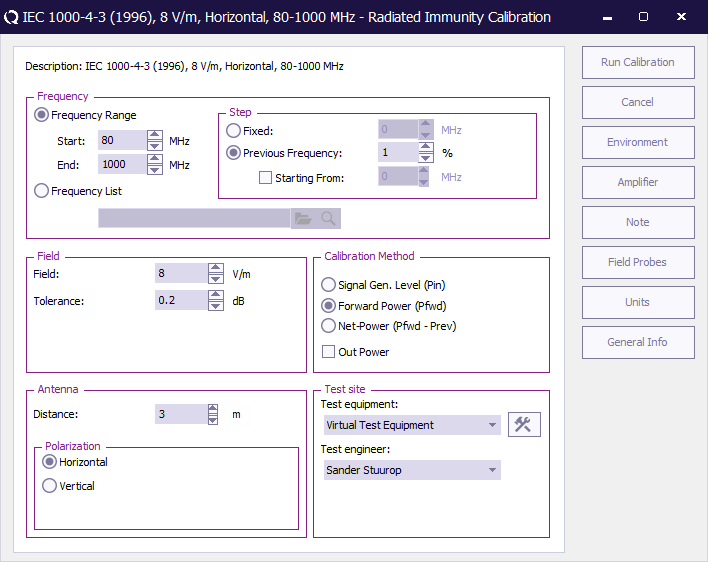
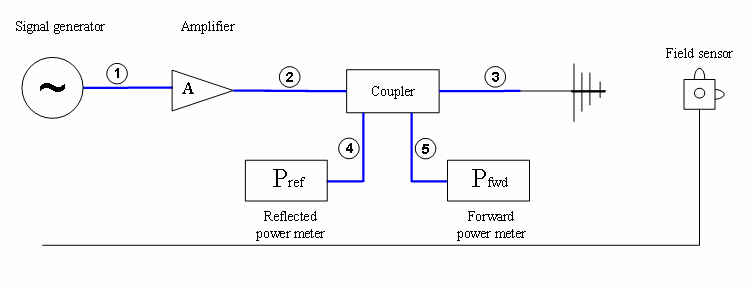
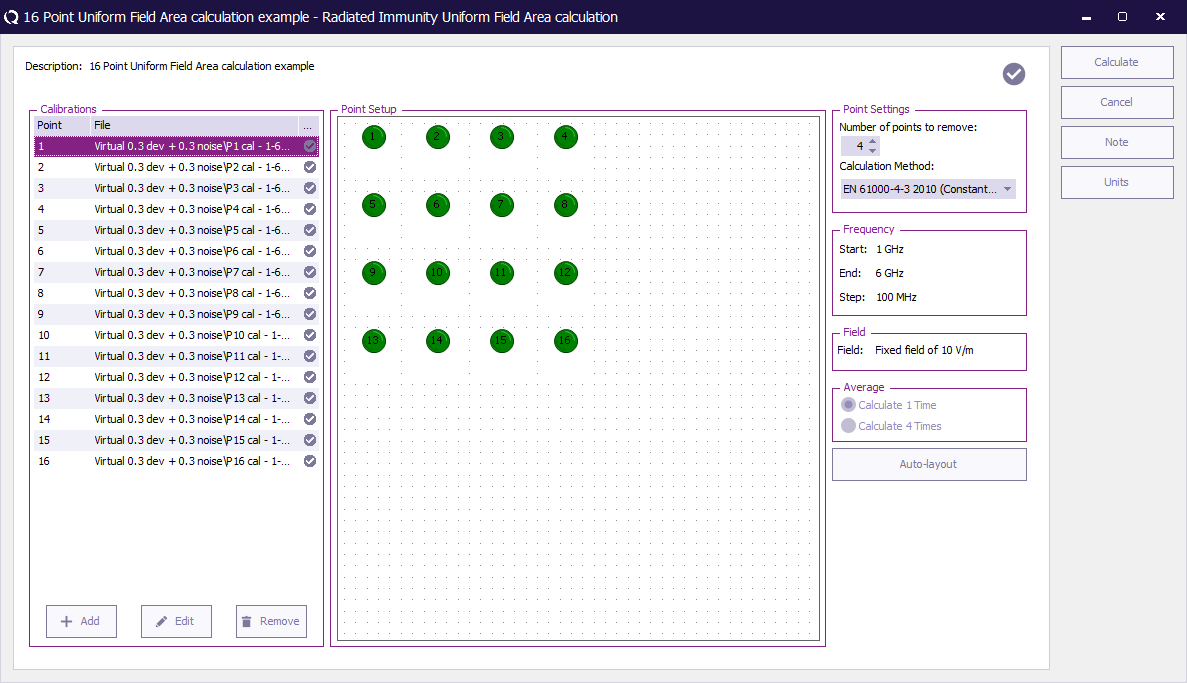
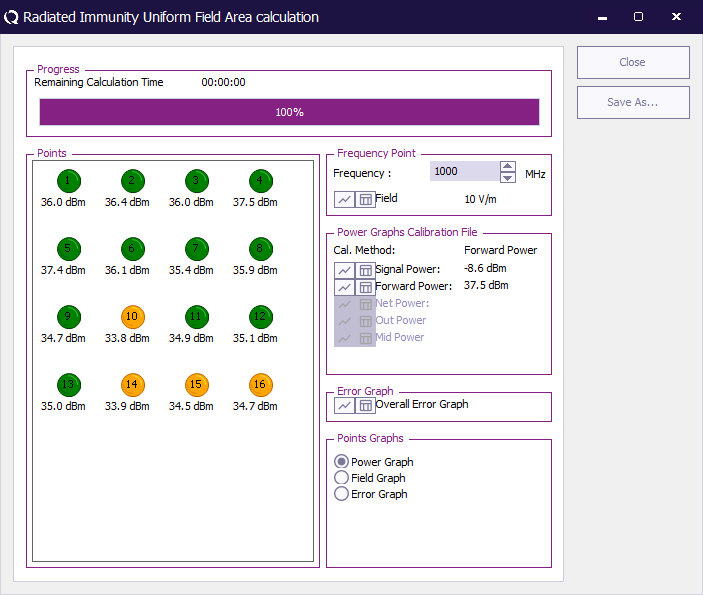
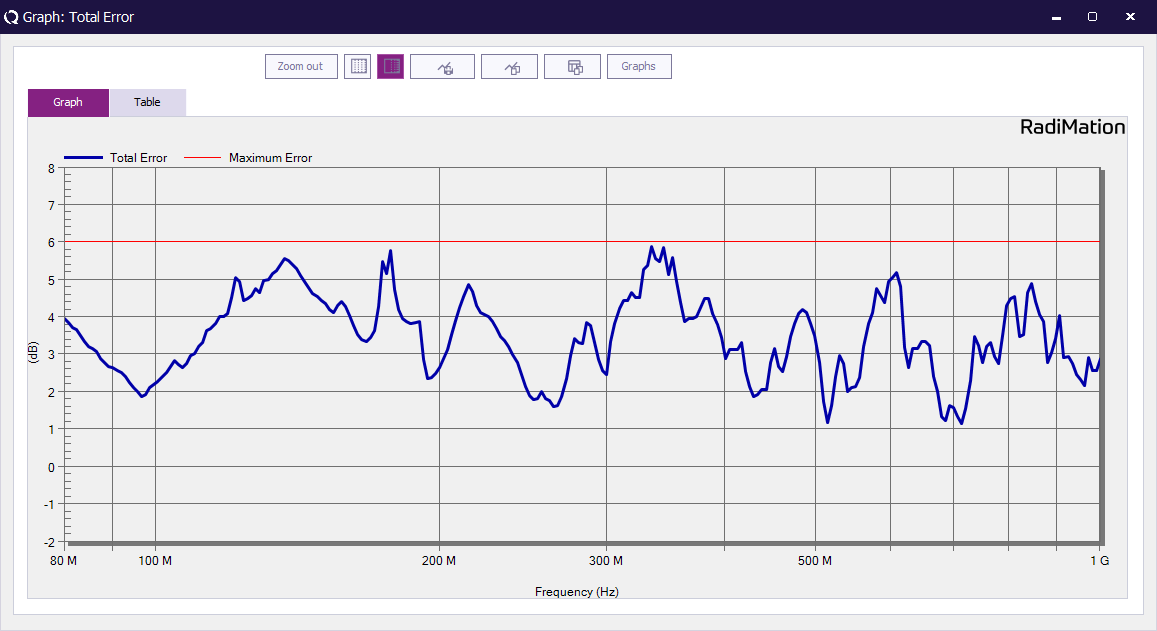
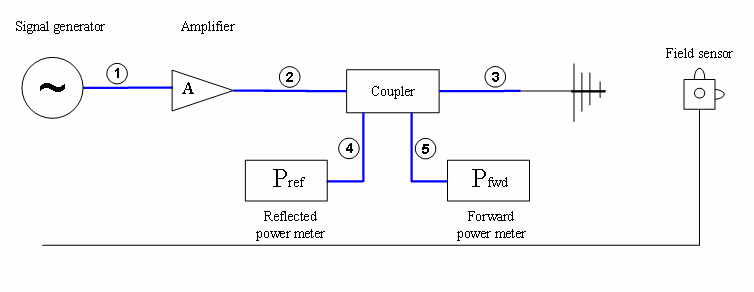
![{\displaystyle Z(f)=h^{2}*{\frac {{E_{avg}}^{2}(f)}{P_{mid}(f)}}[\Omega ]}](https://wikimedia.org/api/rest_v1/media/math/render/svg/77937bcf79ab8784aa7ce128a92618cabf948318)
![{\displaystyle P_{mid}(f)={\frac {P_{net}(f)[W]+P_{out}(f)[W]}{2}}}](https://wikimedia.org/api/rest_v1/media/math/render/svg/314e7cd0304dcce9e77cbd855c5c08b1d46f04a2)
![{\displaystyle U_{powerhead}=U_{rms}-6[dB]-20*^{10}Log{\frac {50}{150}}=U_{rms}-15,6[dB]}](https://wikimedia.org/api/rest_v1/media/math/render/svg/48a0719a6713ee6616a5a5d6d6201230c50ec154)
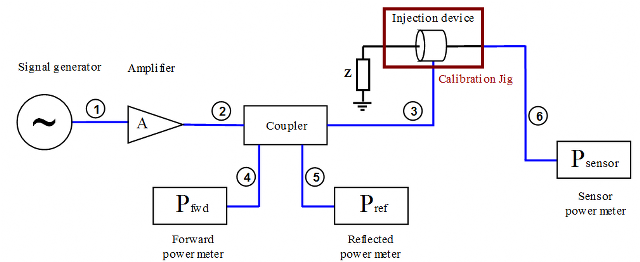
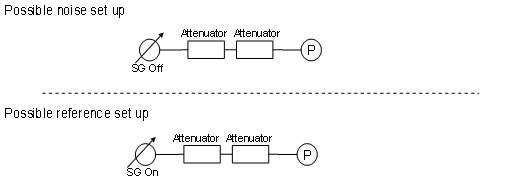
![{\displaystyle Dynamic\ rang[dB]=P_{on}[dBm]-P_{off}[dBm]}](https://wikimedia.org/api/rest_v1/media/math/render/svg/1b09e0525b524537b221b69dd0f40b4deddbcd51)
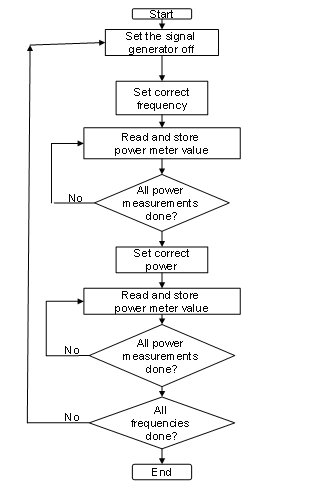
![{\displaystyle P_{Power\ Measurement}(f)[dBm]=10*^{10}log({\frac {\sum _{N}^{i=1}10^{\frac {P_{powermeter(f,i)[dBm]}}{10}}}{N}})}](https://wikimedia.org/api/rest_v1/media/math/render/svg/1ae125e050da43e4242321851eadbf9719fcd4c8)


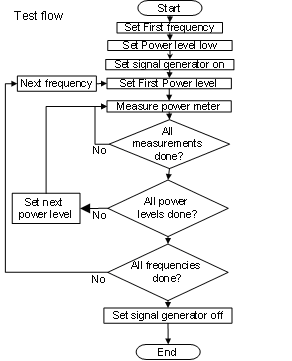
![{\displaystyle P_{power\ measurement}(f)[dBm]=10*^{10}log({\frac {\sum _{i=1}^{N}10^{\frac {P_{powermeter}(f,i)[dBm]}{10}}}{N}})}](https://wikimedia.org/api/rest_v1/media/math/render/svg/31845b9f62f4e66ba8e1067e5331fcdab878422e)
